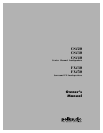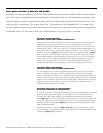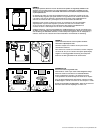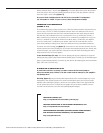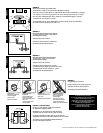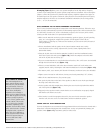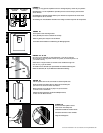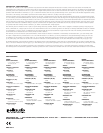
Bi-amping [figure 9] allows you to use separate amplifiers for the high and low frequency
sections of your loudspeaker for greater dynamic range and lower distortion. After removing the
jumpers, connect the speaker wires from the high frequency amplifier outputs to the upper set
of terminal posts on each speaker. Follow the same procedure for connecting the low frequency
amplifier outputs to the lower set of terminals. Remember to maintain correct wiring polarity
(+ to +, - to -) in all connections.
WALL MOUNTING THE FXi SERIES SURROUND LOUDSPEAKER
The FX Series Surround Loudspeakers feature built-in wall mounting brackets. Follow the steps
below to safely wall mount these speakers. Wall mounting requires basic skills in with tools such
as a drill and a screwdriver. If you are in doubt that you possess the necessary skills or tools,
consult your Polk Audio dealer, or a professional installer.
• Make sure the material on which you plan to mount the speakers (plaster, drywall, paneling,
stone, etc.) can support the weight of the speakers (FXi30=approx 13lbs/5.9kg ea.,
FXi50=approx 15.5lbs/7kg ea.). Make sure the locations you select do not conceal electrical
wiring or plumbing.
• Prior to installation, hold the speaker in the chosen location to make sure it safely
clears obstacles such as ceiling, adjacent walls, corners, beams, lighting fixtures and
door/window frames.
• Using the keyhole slots in the bracket template (included), mark the installation location
of the four keyhole slots with a pencil [figure 10]. Orient the template so that the small
ends of the keyhole slots are facing “up.”
• If you are certain that there is a stud behind the wall surface, drive a #10 screw (not included)
through the wall and into the stud [figure 11a].
• If there is no stud behind the wall at the chosen location, install a #10 wall anchor (not
supplied) into the wall by following the wall-anchor-manufacturer’s instructions [figure 11b].
• For masonry walls, use a masonry drill bit and #10 masonry anchor and screw (not included).
•Tighten screws into stud or wall anchors, leaving screw heads protruding 1/16” (1.6mm).
• Make all wire attachments now. (See previous page.)
• Line up the keyhole slots on the back of the speakers so that the screw heads pass through
the large center hole of the slots.
• Let the speaker and slide straight down, allowing the screw head to slip behind the smaller
end of the keyhole slot [figure 12].
•Tug gently on the speaker to make certain that the screws and bracket are properly aligned
and that the wall anchors are secure.
• If the bracket is not held snug against the wall by the screw heads, remove the speaker
from the wall, drive the screws in a little further and then remount the speaker.
TAKING CARE OF YOUR LOUDSPEAKERS
Your new Loudspeakers are constructed of a rugged material that can be dusted or cleaned with a
damp cloth. Avoid harsh detergents and cleaning fluids, as they can permanently damage your
speakers’ finish [figure 13]. Vacuum the grilles to remove dust.
Contact Polk Audio Customer Service 1-800-377-7655 (Outside US: 410-358-3600), polkcs@polkaudio.com
SAFE LIMITS OF OPERATION
Your Polk loudspeakers are
made with the highest quality
materials for years of trouble-
free performance. However,
damage to loudspeakers can
occur when an amplifier,
regardless of its wattage, is
made to play at higher listening
levels than its power can clearly
produce (usually beyond the
“1 to 2 o’clock” position on the
volume control). This results
in very high levels of audible
distortion, originating in the
amplifier, that can add a harsh,
gritty sound to music. Contrary
to popular belief, a speaker is
more likely to be damaged by
trying to get too much volume
from a low-powered amp or
receiver than from a high
powered one.



